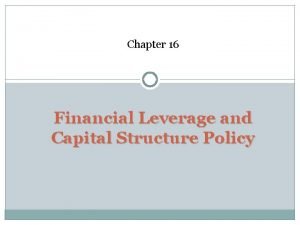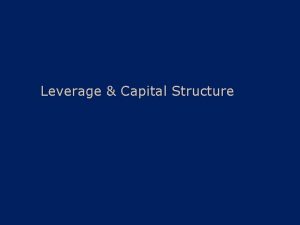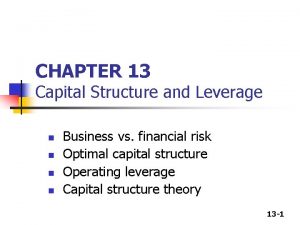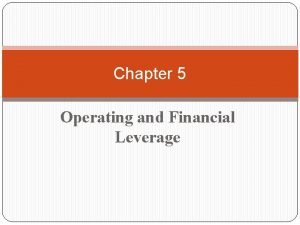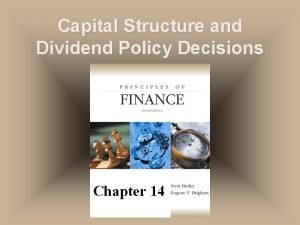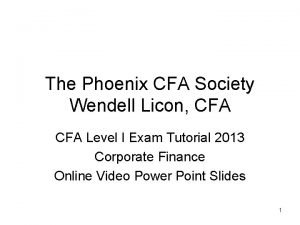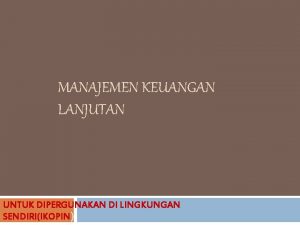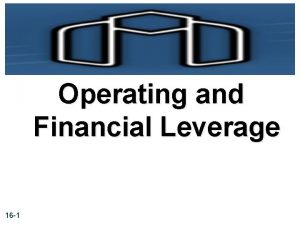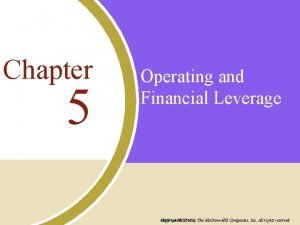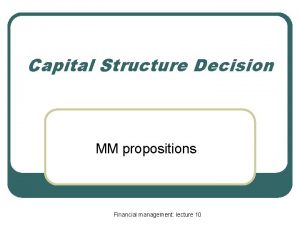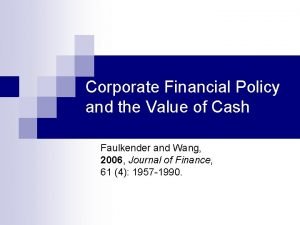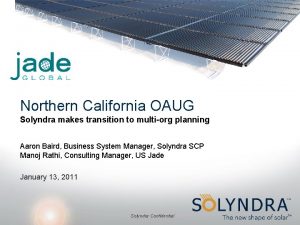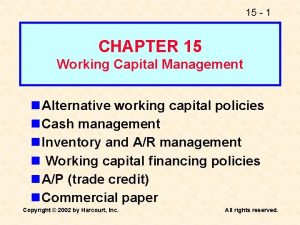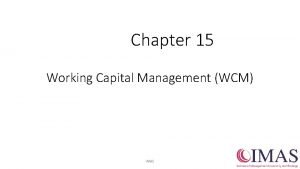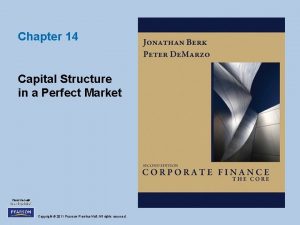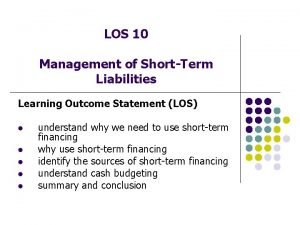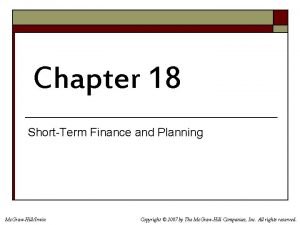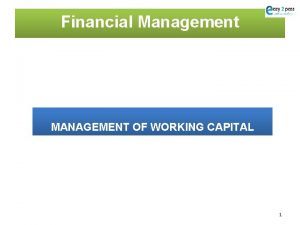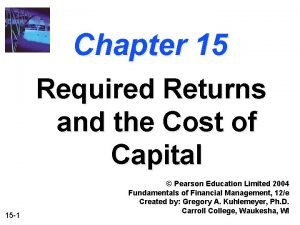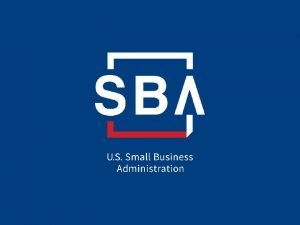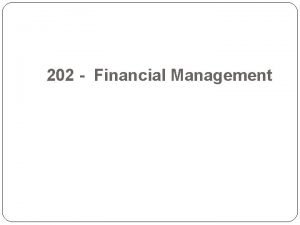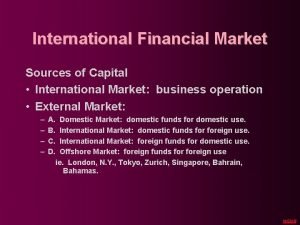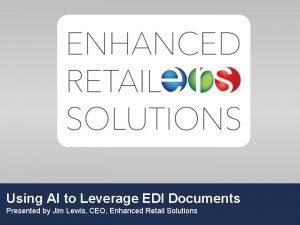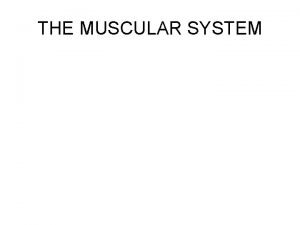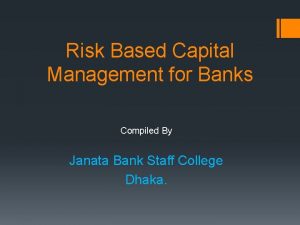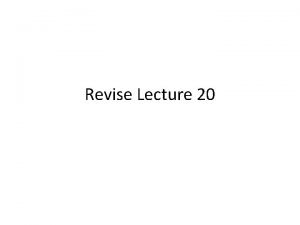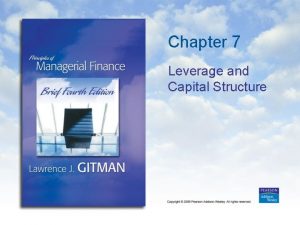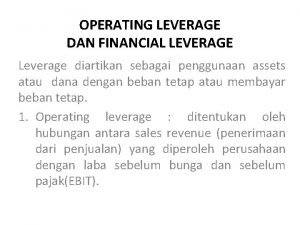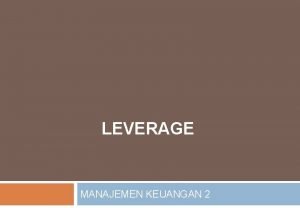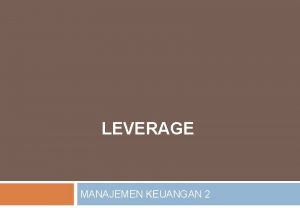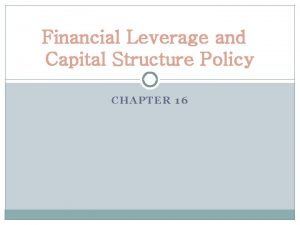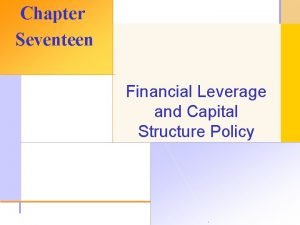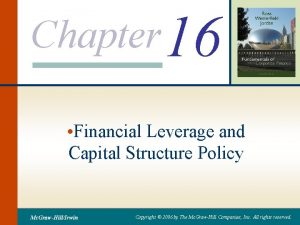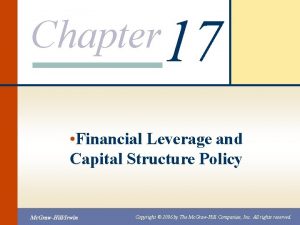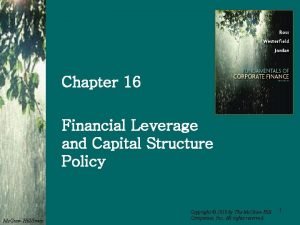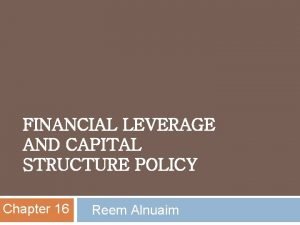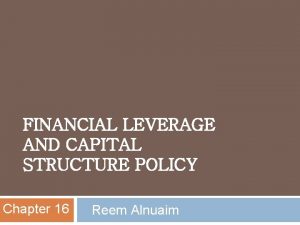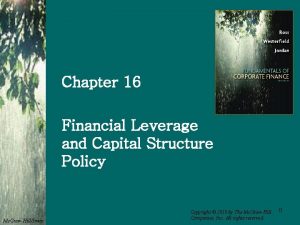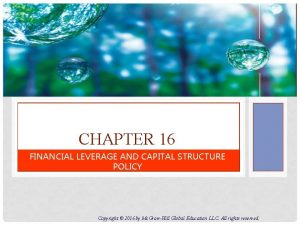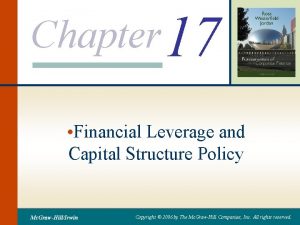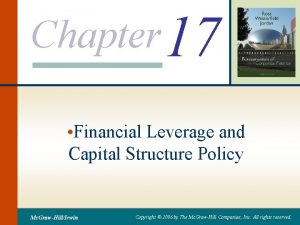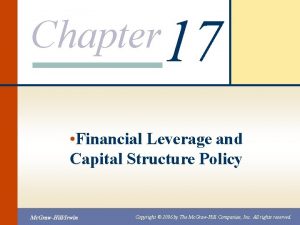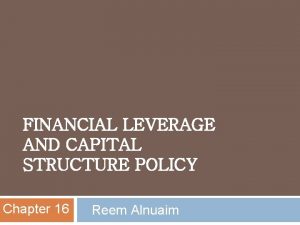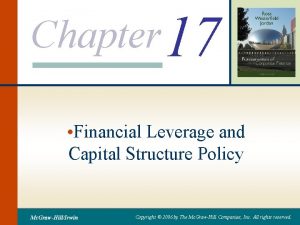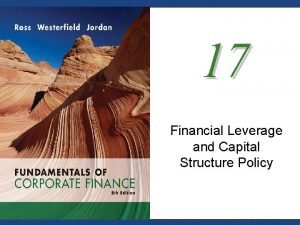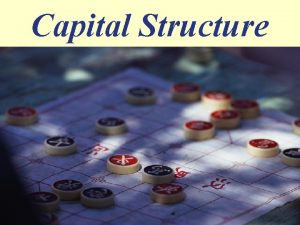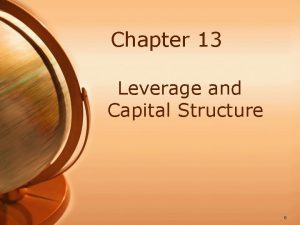FINANCIAL LEVERAGE AND CAPITAL STRUCTURE POLICY Chapter 16











































- Slides: 43

FINANCIAL LEVERAGE AND CAPITAL STRUCTURE POLICY Chapter 16 Reem Alnuaim

Course Roadmap Chapte Topic r Focus 15 Raising Capital All 14 Cost of Capital All 9 Net Present Value and Other Investment Criteria All 11 Project Analysis and Evaluation All 16 Financial Leverage and Capital All Structure Policy 10 Making Capital Investment Decision All 17 Dividends Theory All Exam Mid-Term

Capital Restructuring What is meant by capital restructuring What is the primary goal of financial managers? Can leverage help in achieving such goals?

Capital Restructuring We are going to look at how changes in capital structure affect the value of the firm, all else equal Capital restructuring involves changing the amount of leverage a firm has without changing the firm’s assets The firm can increase leverage by issuing debt and repurchasing outstanding shares The firm can decrease leverage by issuing new shares and retiring outstanding debt

Capital Restructuring How should a firm go about choosing its debt– equity ratio? We assume that the guiding principle is to choose the course of action that maximizes the value of a share of stock. When it comes to capital structure decisions, this is essentially the same thing as maximizing the value of the whole firm, and, for convenience, we will tend to frame our discussion in terms of firm value

FIRM VALUE AND STOCK VALUE: AN EXAMPLE The following example illustrates that the capital structure that maximizes the value of the Firm is the one financial managers should choose for the shareholders, so there is no conflict in our goals. To begin, suppose the market value of the J. J. Sprint Company is $1, 000. The company currently has no debt, and J. J. Sprint’s 100 shares sell for $10 each. Further suppose that J. J. Sprint restructures itself by borrowing $500 and then paying out the proceeds to shareholders as an extra dividend of $500/ 100 = $5 per share. This restructuring will change the capital structure of the firm with no direct effect on the firm’s assets. The immediate effect will be to increase debt and decrease equity

for ease of presentation, we describe the impact of leverage in terms of its effects on earnings per share, EPS, and return on equity, ROE. These are, of course, accounting numbers and, as such, are not our primary concern. Using cash flows instead of these accounting numbers would lead to precisely the same conclusions, but a little more work would be needed. We discuss the impact on market values in a subsequent section.


Choosing a Capital Structure What is the primary goal of financial managers? � Maximize stockholder wealth We want to choose the capital structure that will maximize stockholder wealth We can maximize stockholder wealth by maximizing the value of the firm or minimizing the WACC

Financial Leverage The extent to which a firm relies on debt The more debt financing a firm uses in its capital structure, the more financial leverage it employs

Break-Even EBIT Find EBIT where EPS is the same under both the current and proposed capital structures If we expect EBIT to be greater than the breakeven point, then leverage is beneficial to our stockholders If we expect EBIT to be less than the break-even point, then leverage is detrimental to our stockholders

Ex 1 Page 569 Maynard, Inc. , has no debt outstanding and a total market value of 250, 000$. EBIT are projected to be 28, 000$ if economic conditions are normal. If there is strong expansion in the economy, then EBIT will be 30 percent higher. If there is a recession, then EBIT will be 50 percent lower. Maynard is considering a 90, 000$ debt issue with a 7 percent interest rate. The proceeds will be used to repurchase a share of stock. There are currently 5, 000 shares outstanding. Ignore taxes for this problem A. Calculate EPS under each of the three economic scenarios before any debt is issued. Also calculate the percentage changes in EPS when the economy expands or enters a recession. B. Repeat part (a) assuming that the economy goes with recapitalization. What do you observe?

Ex 4 Page 542 James Corporation is comparing two different capital structures: an all equity plan (plan I) and a levered plan (plan II). Under plan I, the company would have 160, 000 shares of stock outstanding. Under plan II, there would be 80, 000 shares of stock outstanding and 2. 8$ million in debt outstanding. The interest rate on the debt is 8 percent and there are no taxes. A. If EBIT is 350, 000$, which plan will result in the higher EPS? B. If EBIT is 500, 000$, which plan will result in the higher EPS? C. What is the break-even EBIT?

Corporate borrowing & home made leverage homemade leverage: The use of personal borrowing to change the overall amount of financial leverage to which the individual is exposed.

Proposed Capital Structure versus Original Capital Structure with Homemade Leverage

Proposed Capital Structure versus Original Capital Structure with Homemade Leverage This example demonstrates that investors can always increase financial leverage themselves to create a different pattern of payoffs. It thus makes no difference whether Trans Am chooses the proposed capital structure.

Unlevering the Stock suppose management adopts the proposed capital structure. Further suppose that an investor who owned 100 shares preferred the original capital structure. Show this investor could “unlever” the stock to recreate the original payoffs. To create leverage, investors borrow on their own. To undo leverage, investors must lend money. In the case of Trans Am, the corporation borrowed an amount equal to half its value. The investor can unlever the stock by simply lending money in the same proportion. In this case, the investor sells 50 shares for $1, 000 total and then lends the $1, 000 at 10 percent. The payoffs are calculated in the following table:


Capital Structure and the Cost of Equity Capital Modigliani and Miller (M&M)Theory of Capital Structure � Proposition I – firm value � Proposition II – WACC The value of the firm is determined by the cash flows to the firm and the risk of the assets Changing firm value � Change the risk of the cash flows � Change the cash flows

Capital Structure Theory Under Three Special Cases Case I – Assumptions � No corporate or personal taxes � No bankruptcy costs Case II – Assumptions � Corporate taxes, but no personal taxes � No bankruptcy costs Case III – Assumptions � Corporate taxes, but no personal taxes � Bankruptcy costs

Case I – Propositions I and II Proposition I � The value of the firm is NOT affected by changes in the capital structure � The cash flows of the firm do not change; therefore, value doesn’t change Proposition II � The WACC of the firm is NOT affected by capital structure

Case I - Equations WACC = RA = (E/V)RE + (D/V)RD RE = RA + (RA – RD)(D/E) � RA is the “cost” of the firm’s business risk, i. e. , the risk of the firm’s assets � (RA – RD)(D/E) is the “cost” of the firm’s financial risk, i. e. , the additional return required by stockholders to compensate for the risk of leverage

Case I - Example Data � What is the cost of equity? � Required return on assets = 16%; cost of debt = 10%; percent of debt = 45% RE = 16 + (16 - 10)(. 45/. 55) = 20. 91% Suppose instead that the cost of equity is 25%, what is the debt-to-equity ratio? 25 = 16 + (16 - 10)(D/E) � D/E = (25 - 16) / (16 - 10) = 1. 5 � Based on this information, what is the percent of equity in the firm? � E/V = 1 / 2. 5 = 40%

The CAPM, the SML and Proposition II How does financial leverage affect systematic risk? CAPM: RA = Rf + A(RM – Rf) � Where A is the firm’s asset beta and measures the systematic risk of the firm’s assets Proposition II � � Replace RA with the CAPM and assume that the debt is riskless (RD = Rf) RE = Rf + A(1+D/E)(RM – Rf)

Business Risk and Financial Risk RE = Rf + A(1+D/E)(RM – Rf) CAPM: RE = Rf + E(RM – Rf) � E = A(1 + D/E) Therefore, the systematic risk of the stock depends on: risk of the assets, A, (Business risk) � Level of leverage, D/E, (Financial risk) � Systematic

Case II – Cash Flow Interest is tax deductible Therefore, when a firm adds debt, it reduces taxes, all else equal The reduction in taxes increases the cash flow of the firm How should an increase in cash flows affect the value of the firm?

Case II - Example

Interest Tax Shield Annual interest tax shield � Tax rate times interest payment � 6, 250 in 8% debt = 500 in interest expense � Annual tax shield =. 34(500) = 170 Present value of annual interest tax shield � Assume perpetual debt for simplicity � PV = 170 /. 08 = 2, 125 � PV = D(RD)(TC) / RD = DTC = 6, 250(. 34) = 2, 125

Case II – Proposition I The value of the firm increases by the present value of the annual interest tax shield � Value of a levered firm = value of an unlevered firm + PV of interest tax shield � Value of equity = Value of the firm – Value of debt Assuming perpetual cash flows � VU = EBIT(1 -T) / RU � VL = VU + DTC

Example: Case II – Proposition I Data � EBIT = 25 million; Tax rate = 35%; Debt = $75 million; Cost of debt = 9%; Unlevered cost of capital = 12% VU = 25(1 -. 35) /. 12 = $135. 42 million VL = 135. 42 + 75(. 35) = $161. 67 million E = 161. 67 – 75 = $86. 67 million

Case II – Proposition II The WACC decreases as D/E increases because of the government subsidy on interest payments � RA = (E/V)RE + (D/V)(RD)(1 -TC) � RE = RU + (RU – RD)(D/E)(1 -TC) Example � RE = 12 + (12 -9)(75/86. 67)(1 -. 35) = 13. 69% � RA = (86. 67/161. 67)(13. 69) + (75/161. 67)(9)(1 -. 35) RA = 10. 05%

Example: Case II – Proposition II Suppose that the firm changes its capital structure so that the debt-to-equity ratio becomes 1. What will happen to the cost of equity under the new capital structure? � RE = 12 + (12 - 9)(1)(1 -. 35) = 13. 95% What will happen to the weighted average cost of capital? � RA =. 5(13. 95) +. 5(9)(1 -. 35) = 9. 9%

Case III Now we add bankruptcy costs As the D/E ratio increases, the probability of bankruptcy increases This increased probability will increase the expected bankruptcy costs At some point, the additional value of the interest tax shield will be offset by the increase in expected bankruptcy cost At this point, the value of the firm will start to decrease, and the WACC will start to increase as more debt is added

Bankruptcy Costs Direct costs � Legal and administrative costs � Ultimately cause bondholders to incur additional losses � Disincentive to debt financing Financial distress � Significant problems in meeting debt obligations � Firms that experience financial distress do not necessarily file for bankruptcy

More Bankruptcy Costs Indirect bankruptcy costs � � � Larger than direct costs, but more difficult to measure and estimate Stockholders want to avoid a formal bankruptcy filing Bondholders want to keep existing assets intact so they can at least receive that money Assets lose value as management spends time worrying about avoiding bankruptcy instead of running the business The firm may also lose sales, experience interrupted operations and lose valuable employees

Conclusions Case I – no taxes or bankruptcy costs � No optimal capital structure Case II – corporate taxes but no bankruptcy costs � Optimal capital structure is almost 100% debt � Each additional dollar of debt increases the cash flow of the firm Case III – corporate taxes and bankruptcy costs � Optimal capital structure is part debt and part equity � Occurs where the benefit from an additional dollar of debt is just offset by the increase in expected bankruptcy costs

Managerial Recommendations The tax benefit is only important if the firm has a large tax liability Risk of financial distress � The greater the risk of financial distress, the less debt will be optimal for the firm � The cost of financial distress varies across firms and industries, and as a manager you need to understand the cost for your industry

The Value of the Firm Value of the firm = marketed claims + nonmarketed claims � � Marketed claims are the claims of stockholders and bondholders Nonmarketed claims are the claims of the government and other potential stakeholders The overall value of the firm is unaffected by changes in capital structure The division of value between marketed claims and nonmarketed claims may be impacted by capital structure decisions

The Pecking-Order Theory stating that firms prefer to issue debt rather than equity if internal financing is insufficient. � � Rule 1 Use internal financing first Rule 2 Issue debt next, new equity last The pecking-order theory is at odds with the tradeoff theory: � � � There is no target D/E ratio Profitable firms use less debt Companies like financial slack

Observed Capital Structure Capital structure does differ by industry Differences according to Cost of Capital 2008 Yearbook by Ibbotson Associates, Inc. � Lowest levels of debt Computers with 5. 61% debt Drugs with 7. 25% debt � Highest levels of debt Cable television with 162. 03% debt Airlines with 129. 40% debt

Bankruptcy Process – Part I Business failure – business has terminated with a loss to creditors Legal bankruptcy – petition federal court for bankruptcy Technical insolvency – firm is unable to meet debt obligations Accounting insolvency – book value of equity is negative

Bankruptcy Process – Part II Liquidation � Chapter 7 of the Federal Bankruptcy Reform Act of 1978 � Trustee takes over assets, sells them and distributes the proceeds according to the absolute priority rule Reorganization � Chapter 11 of the Federal Bankruptcy Reform Act of 1978 � Restructure the corporation with a provision to repay creditors

Ethics Issues Suppose managers of a firm know that the company is approaching financial distress. � � Should the managers borrow from creditors and issue a large one-time dividend to shareholders? How might creditors control this potential transfer of wealth?
 Financial leverage and capital structure policy
Financial leverage and capital structure policy Capital structure leverage
Capital structure leverage Operating leverage and financial leverage formula
Operating leverage and financial leverage formula Chapter 13 leverage and capital structure gitman ppt
Chapter 13 leverage and capital structure gitman ppt Operating and financial leverage chapter 5
Operating and financial leverage chapter 5 Business risk and financial risk leverage
Business risk and financial risk leverage Types of dividend policy
Types of dividend policy Multinational capital structure
Multinational capital structure Multinational cost of capital and capital structure
Multinational cost of capital and capital structure Wacc formule
Wacc formule Rumus dol, dfl dcl
Rumus dol, dfl dcl Floatation cost
Floatation cost An ebit eps indifference analysis chart is used for
An ebit eps indifference analysis chart is used for Financial leverage deals with
Financial leverage deals with M&m propositions
M&m propositions Working capital introduction
Working capital introduction Source of capital reserve
Source of capital reserve Difference between capital reserve and reserve capital
Difference between capital reserve and reserve capital Variable capital examples
Variable capital examples Corporate financial policy and the value of cash
Corporate financial policy and the value of cash Savers and investors role in financial markets
Savers and investors role in financial markets Efficient capital allocation
Efficient capital allocation Lift and leverage
Lift and leverage Working capital financing policy
Working capital financing policy Maturity matching working capital financing policy
Maturity matching working capital financing policy Capital structure in a perfect market
Capital structure in a perfect market Basle ii
Basle ii Regulatory capital vs economic capital
Regulatory capital vs economic capital Capital allocation line vs capital market line
Capital allocation line vs capital market line Non financial methods of motivation
Non financial methods of motivation Managing short term assets and liabilities
Managing short term assets and liabilities A flexible short term financial policy
A flexible short term financial policy Dividend policy decision in financial management
Dividend policy decision in financial management Dividend policy decision in financial management
Dividend policy decision in financial management Long term financing
Long term financing Cost of capital in financial management
Cost of capital in financial management Caweb sba
Caweb sba What is working capital in financial management
What is working capital in financial management Capital international financial
Capital international financial How to leverage edi
How to leverage edi Muscles of the posterior leg
Muscles of the posterior leg High leverage point vs outlier
High leverage point vs outlier Basel 3 norms
Basel 3 norms Different types of leverage
Different types of leverage
